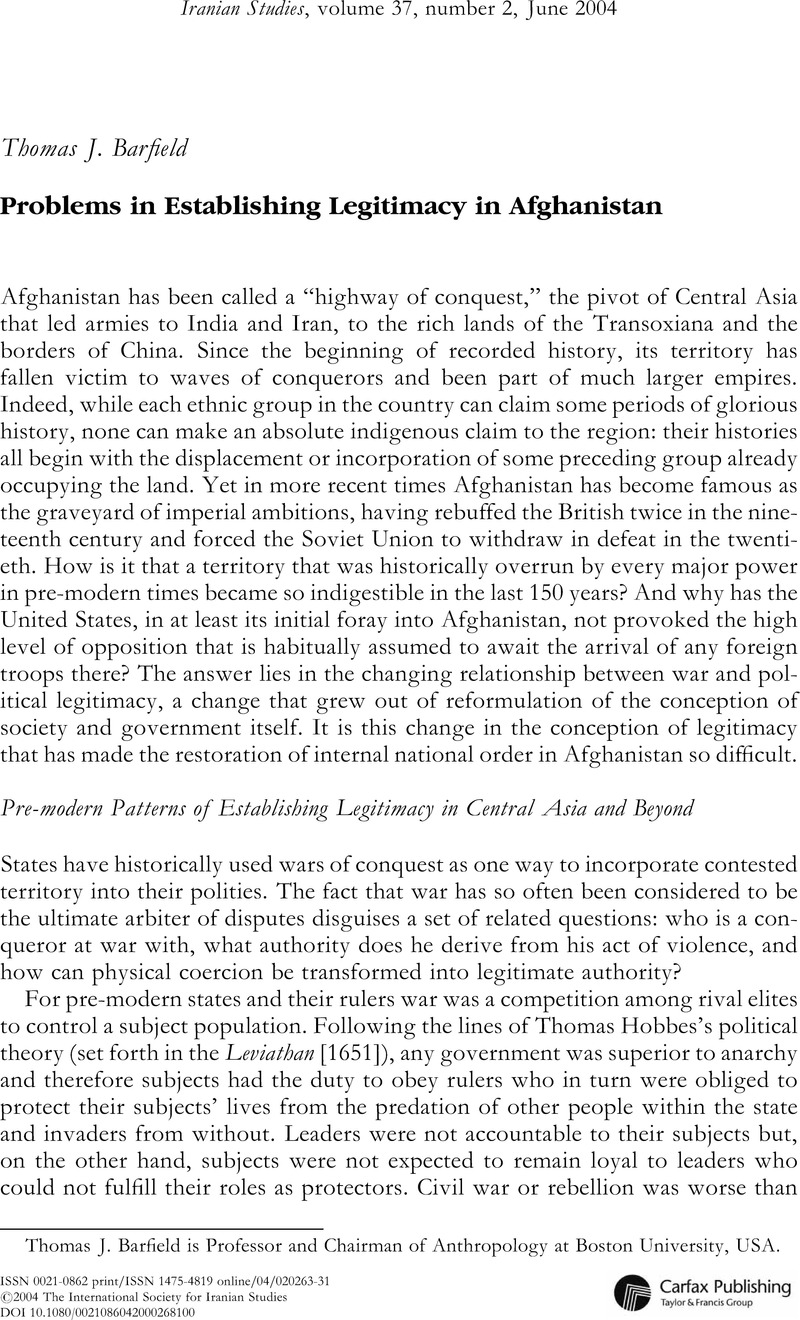Article contents
Problems in Establishing Legitimacy in Afghanistan
Published online by Cambridge University Press: 01 January 2022
Abstract

- Type
- Articles
- Information
- Copyright
- Copyright © 2004 The International Society for Iranian Studies
References
1 Barthold, V.V., Turkestan Down to the Mongol Invasion (London, 1968), 291Google Scholar.
2 Barthold, Turkestan Down to the Mongol Invasion, 377.
3 In addition certain physical defects were considered debilitating. For example, in Afghan politics losers were often blinded instead of killed because this rendered them ineligible to rule and removed them from the game.
4 Except for Mongol Empire's Chinggis Khan, who, not understanding the ritual nature of such challenges, had the populations of rebellious cities exterminated so that there would be no cities to rebel in the future.
5 Sa'di, . The Gulistan (Book 1, #14), trans. Rehatsek, Edward (New York, 1965), 48–49Google Scholar.
6 Khaldun, ibn, The Muqaddimah: An Introduction to History, abridged edition, trans. Rosenthal, Franz (Princeton, 1967)Google Scholar.
7 ibn Khaldun, The Muqaddimah, 122.
8 Ahmed, Akbar, Pukhtun Economy and Society (London, 1980)Google Scholar.
9 Barfield, Thomas, “Tribe and State Relations: The Inner Asian Perspective,” in Tribes and State Formation in the Middle East, ed. Koury, Philip S. and Kostiner, Joseph (Berkeley, 1991), 153–185Google Scholar.
10 Lockhart, Laurence, The fall of the Safavi dynasty and the Afghan occupation of Persia (Cambridge, 1958)Google Scholar.
11 Lockhart, Laurence, Nadir Shah: A Critical Study Based Mainly upon Contemporary Sources (London, 1938)Google Scholar.
12 Singh, Ganda, Ahmad Shah Durrani (London, 1959)Google Scholar.
13 Noelle, Christine, State and Tribe in 19th century Afghanistan: The Reign of Amir Dost Muhammad Khan (1826–1863) (London, 1997)Google Scholar.
14 Yapp, Malcolm, “The Revolutions of 1841–42 in Afghanistan,” Bulletin of the School of Oriental and African Studies, 27 (1964): 333–381CrossRefGoogle Scholar. Hanifi, Shah Mahmoud, Inter-regional Trade and Colonial State Formation in 19th Century Afghanistan (Ph.D. Dissertation. University of Michigan, 2001): 58Google Scholar.
15 see Noelle, Christine, State and Tribe in 19th Century Afghanistan (London, 1997), 53–55Google Scholar for a good comparison of these views).
16 Yapp, “The Revolutions of 1841–42 in Afghanistan,” 381.
17 Hanifi, Inter-regional Trade, 261; Noelle, State and Tribe, 250.
18 A jezail was a locally produced Afghan musket. Kipling, Rudyard, The Works of Rudyard Kipling (Roslyn, NY, n.d.)Google Scholar
19 Robson, Brian, The Road to Kabul: the Second Afghan War, 1878–1881 (Staplehurst, UK, 2003)Google Scholar; Heathcote, T. A., The Afghan Wars, 1839–1919. (London, 1980)Google Scholar.
20 Kakar, Hasan, Afghanistan: A Study in Internal Political Developments, 1880–1896 (Kabul, 1971)Google Scholar.
21 Hanifi, Inter-regional Trade.
22 Dupree, Louis, Afghanistan (Princeton, 1978), 419Google Scholar; Tapper, Nancy, “Abd al-Rahman's North-west Frontier: The Pashtun Colonisation of Afghan Turkistan,” in The Conflict of Tribe and State in Iran and Afghanistan, ed. Tapper, Richard (London: 1983) 233–261Google Scholar; Kakar, Hasan, Government and Society in Afghanistan: The Reign of Amir Abd al-Rahman Khan (Austin, 1979)CrossRefGoogle Scholar.
23 Ferdinand, Klaus, “Nomadic Expansion and Commerce in Central Afghanistan, a Sketch of Some Modern Trends.” Folk 4 (1962) 123–160Google Scholar.
24 Kakar, Hasan, Afghanistan: A Study in Internal Political Developments, 1880–1896 (Kabul, 1971), 181–210Google Scholar.
25 Poullada, Leon B., Reform and Rebellion in Afghanistan, 1919–1929 (Ithaca, 1973)Google Scholar.
26 Rubin, Barnett R, The Fragmentation of Afghanistan: State Formation and Collapse in the International System (New Haven 1995), 90, 92Google Scholar.
27 Bradsher, Henry S., Afghanistan and the Soviet Union (Durham, NC, 1985)Google Scholar
28 Giustozzi, Antonio, War, Politics and Society in Afghanistan, 1978–1992 (London, 2000).Google Scholar
29 Barfield, Thomas, “The Afghan Morass,” Current History 95 (1996): 38–43Google Scholar.
30 Rubin, Barnett, The Search for Peace in Afghanistan: From Buffer State to Failed State (New Haven, 1995).Google Scholar
31 ibn Khaldun, The Muqaddimah, 120.
32 Rashid, Ahmad, Taliban: Militant Islam, Oil and Fundamentalism in Central Asia (New Haven, 2001)Google Scholar; Goodson, Larry, Afghanistan's Endless War: State Failure, Regional Politics and the Rise of the Taliban (Seattle, 2001)Google Scholar; Coll, Steve, Ghost Wars (New York, 2004)Google Scholar.
33 The closest analogy of this pre-modern process is found today during hostile takeovers by multi-national corporations. As factory workers and paper pushers continue their usual patterns of work, rival teams of mercenary lawyers waving proxy votes engage in furious battle to gain control of the target corporation's assets. Upon victory the winning side purges losing corporate board members and executives, and installs its own. Nothing changes on the factory floor during this process, and workers ordinarily are not expected to take part in the struggle or ratify its outcome despite the fact that they have as much or more to lose or gain from the new owners' policies than other players.
- 22
- Cited by




